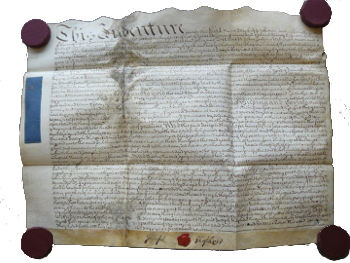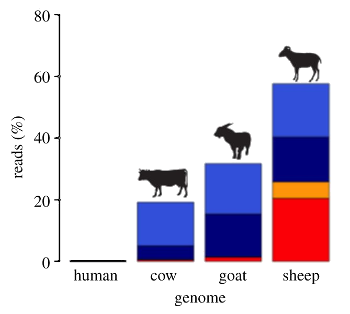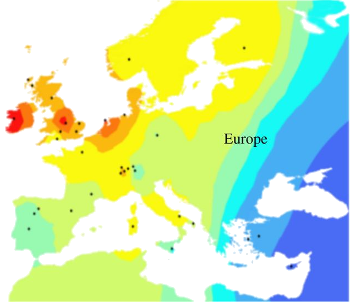Parchment DNA
February 26, 2015
As
Marshall McLuhan so famously stated, "
the medium is the message." He reasoned that the
medium influences the
perception of content, and I notice that when I compare
movies with the
books on which they're based. Some
scientists from
Trinity College Dublin have taken this saying literally, as they have been examining
DNA and
protein from the
parchment of
documents written in the
17th and
18th centuries.[1-3]
Parchment is a
writing material made from the
skin of
animals, such as
sheep and
calves. Parchment was used as a writing medium more than two thousand years ago. The
Dead Sea Scrolls were written on
ibex and
goat parchment. Even after the widespread use of
paper, parchment was reserved for important documents for which common paper was deemed too impermanent.

A parchment dated April 2-15, 1742, from Vicars Choral Estates.
(Trinity College Dublin Image, by permission of the Borthwick Institute for Archives.)
Parchment could be an invaluable aid in the study of the
historical proliferation of
livestock species, since there are millions of parchment documents in
archives, and the parchments are closely dated to the
manuscripts written on them. However, it's always been assumed that
DNA analysis would be a challenge, since there would be cross-individual and cross-species
contamination in the parchment preparation process in which many animal skins might have been washed, cured and
depilated at the same time.[1] To assess the feasibility of such analysis, the Trinity College researchers applied DNA sequencing techniques to a seventeenth century and an eighteenth century parchment.[1-3]
The DNA analysis of these parchments established the type of animal, sheep, from which these parchments were made. Not only that, but these ancient
genomes could be compared to those of their modern equivalents, thus providing a clue to the
genetic diversity of these sheep over time.[2] Says
Daniel Bradley, a
professor of
Population Genetics at Trinity College Dublin,
"Wool was essentially the oil of times gone by, so knowing how human change affected the genetics of sheep through the ages can tell us a huge amount about how Agricultural practices evolved."[2]
Parchment is an unique DNA reservoir, since, unlike
bone remains, it has been carefully preserved above ground in a controlled environment.[1-2] Bone remains contain high levels of
bacterial DNA and low levels of the DNA from whence they came.[1]
Small (2
cm by 2 cm) specimens were obtained from parchments at the
Borthwick Institute for Archives of the University of York. These specimens were used for both DNA analysis and for
mass spectrometric analysis of extracted
collagen.[1-2] One parchment was linked to the black-faced breeds of
northern Britain, while the other had a closer affinity with
Midland and
southern Britain where livestock improvements were common in the later 18th century.[2]

Histogram of raw sequence read alignments (see reference for color codes) that indicate a match to the sheep genome for one of the two parchments in the study.
(Fig. 1(a) from ref. 1, licensed under a Creative Commons Attribution License.)[1)]
Says
Matthew Collins, a professor in the
Department of Archaeology at the University of York,
"We believe the two specimens derive from an unimproved northern hill-sheep typical in Yorkshire in the 17th century, and from a sheep derived from the 'improved' flocks, such as those bred in the Midlands by Robert Bakewell, which were spreading through England in the 18th century. We want to understand the history of agriculture in these islands over the last 1,000 years and, with this breath-taking resource, we can."[2]

A synthetic map of how the genome of one parchment matches the genotypes of modern breeds. "Warmer" colors indicate a better match.
(Fig. 2(b) from ref. 1, licensed under a Creative Commons Attribution License.)[1)]
The number of archived parchments in the
United Kingdom is estimated to be quite large. About 15 million sheep were
slaughtered annually from 1150 to 1850. Estimating that 1% of these became parchment and only 4% of these parchments now survive, gives 4.2 million parchments, although even a lower estimate of a million would be significant.[1] This allows the possibility that historical genetic maps from a variety of
domestic species can be assembled to document the last thousand years of animal breeding history.[1]
References:
- M. D. Teasdale, N. L. van Doorn, S. Fiddyment, C. C. Webb, T. O'Connor, M. Hofreiter, M. J. Collins, and D. G. Bradley, "Paging through history: parchment as a reservoir of ancient DNA for next generation sequencing," Philosophical Transactions of the Royal Society B: Biological Sciences, vol. 370, no. 1660 (January, 2015), DOI: 10.1098/rstb.2013.0379. This is an open access publication with a PDF file available here.
- Thomas Deane, "Scientists reveal parchment's hidden stories," Trinity College Dublin Press Release, December 8, 2914.
- Scientists Reveal Parchment's Hidden Stories, Trinity College Dublin and the University of York YouTube Video, December 8, 2014.
Permanent Link to this article
Linked Keywords: Marshall McLuhan; the medium is the message; medium; perception; film; movie; book; scientist; Trinity College Dublin; DNA; protein; parchment; document; 17th century; 18th century; writing; skin; animal; sheep; calf; calves; Dead Sea Scrolls; capra; ibex; goat; paper; Borthwick Institute for Archives; history; historical; livestock; species; archive; manuscript; genetic testing; DNA analysis; contamination; hair removal; depilate; genome; genetic diversity; Daniel Bradley; professor; Population Genetics; wool; petroleum; oil; agriculture; bone; bacteria; centimeter; cm; mass spectrometry; mass spectrometric analysis; collagen; North Britain; The Midlands; England and Wales; Histogram; nucleic acid sequence; Creative Commons Attribution License; Matthew Collins; Department of Archaeology; Yorkshire; Robert Bakewell; England; United Kingdom; animal slaughter; domestication; domestic.